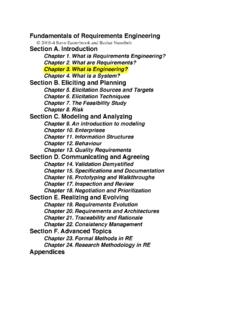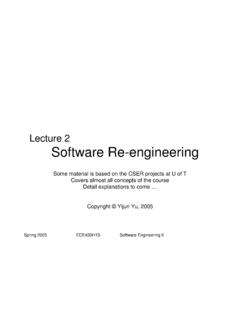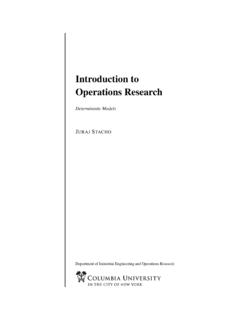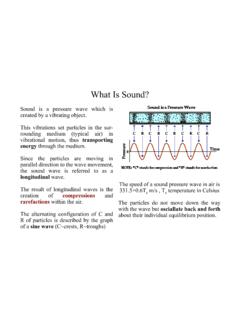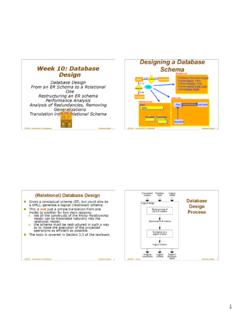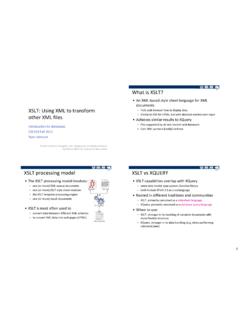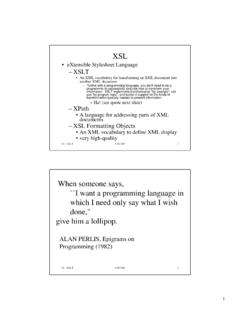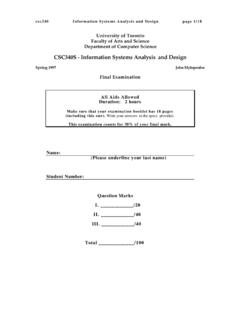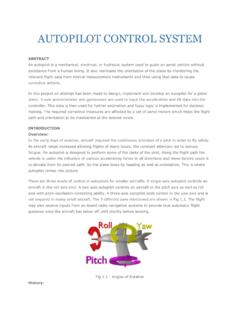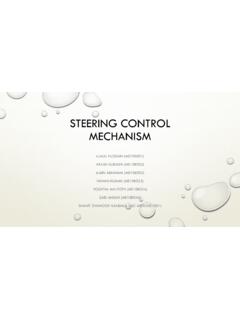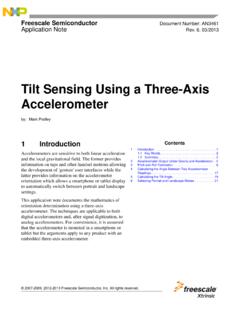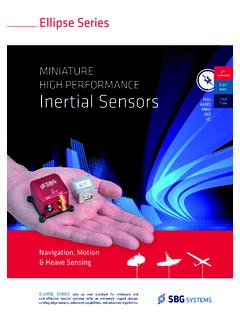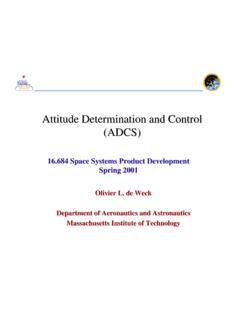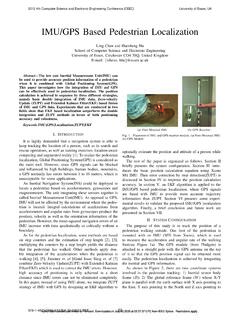Transcription of Are we ready for Autonomous Driving? The KITTI Vision ...
1 Are we ready for Autonomous Driving? The KITTI Vision Benchmark SuiteAndreas Geiger and Philip LenzKarlsruhe Institute of UrtasunToyota Technological Institute at visual recognition systems are still rarely em-ployed in robotics applications. Perhaps one of the mainreasons for this is the lack of demanding benchmarks thatmimic such scenarios. In this paper, we take advantageof our Autonomous driving platform to develop novel chal-lenging benchmarks for the tasks of stereo, optical flow, vi-sual odometry / SLAM and 3D object detection. Our record-ing platform is equipped with four high resolution videocameras, a Velodyne laser scanner and a state-of-the-artlocalization system. Our benchmarks comprise 389 stereoand optical flow image pairs, stereo visual odometry se-quences of km length, and more than 200k 3D ob-ject annotations captured in cluttered scenarios (up to 15cars and 30 pedestrians are visible per image).
2 Resultsfrom state-of-the-art algorithms reveal that methods rank-ing high on established datasets such as Middlebury per-form below average when being moved outside the labora-tory to the real world. Our goal is to reduce this bias byproviding challenging benchmarks with novel difficulties tothe computer Vision community. Our benchmarks are avail-able online IntroductionDeveloping Autonomous systems that are able to assisthumans in everyday tasks is one of the grand challenges inmodern computer science. One example are autonomousdriving systems which can help decrease fatalities causedby traffic accidents. While a variety of novel sensors havebeen used in the past few years for tasks such as recognition,navigation and manipulation of objects, visual sensors arerarely exploited in robotics applications: Autonomous driv-ing systems rely mostly on GPS, laser range finders, radaras well as very accurate maps of the the past few years an increasing number of bench-marks have been developed to push forward the perfor-mance of visual recognitions systems, , Caltech-101 Figure platformwith sensors (top-left),trajectoryfrom our visual odometry benchmark (top-center),disparityandoptical flowmap (top-right) and3D objectlabels (bottom).
3 [17], Middlebury for stereo [41] and optical flow [2] evalu-ation. However, most of these datasets are simplistic, ,are taken in a controlled environment. A notable exceptionis the PASCAL VOC challenge [16] for detection and this paper, we take advantage of our Autonomous driv-ing platform to develop novel challenging benchmarks forstereo, optical flow, visual odometry / SLAM and 3D objectdetection. Our benchmarks are captured by driving around amid-size city, in rural areas and on highways. Our recordingplatform is equipped with two high resolution stereo cam-era systems (grayscale and color), a Velodyne HDL-64 Elaser scanner that produces more than one million 3D pointsper second and a state-of-the-art OXTS RT 3003 localiza-tion system which combines GPS, GLONASS, an IMU andRTK correction signals. The cameras, laser scanner and lo-calization system are calibrated and synchronized, provid-ing us with accurate ground truth.
4 Table 1 summarizes ourbenchmarks and provides a comparison to existing andoptical flowestimation bench-mark comprises194training and195test image pairs ata resolution of1240 376pixels after rectification withsemi-dense (50%) ground truth. Compared to previousdatasets [41, 2, 30, 29], this is the first one with realis-tic non-synthetic imagery and accurate ground truth. Dif-1ficulties include non-lambertian surfaces ( , reflectance,transparency) large displacements ( , high speed), a largevariety of materials ( , matte vs. shiny), as well as differ-ent lighting conditions ( , sunny vs. cloudy).Our3D visual odometry/SLAM dataset consists of22stereo sequences, with a total length Todate, datasets falling into this category are either monocularand short [43] or consist of low quality imagery [42, 4, 35].They typically do not provide an evaluation metric, and asa consequence there is no consensus on which benchmarkshould be used to evaluate visual odometry / SLAM ap-proaches.
5 Thus often only qualitative results are presented,with the notable exception of laser-based SLAM [28]. Webelieve a fair comparison is possible in our benchmark dueto its large scale nature as well as the novel metrics we pro-pose, which capture different sources of error by evaluatingerror statistics over all sub-sequences of a given trajectorylength or driving objectbenchmark focuses on computer visionalgorithms for object detection and 3D orientation estima-tion. While existing benchmarks for those tasks do not pro-vide accurate 3D information [17, 39, 15, 16] or lack real-ism [33, 31, 34], our dataset provides accurate 3D boundingboxes for object classes such as cars, vans, trucks, pedes-trians, cyclists and trams. We obtain this information bymanually labeling objects in 3D point clouds produced byour Velodyne system, and projecting them back into the im-age. This results in tracklets with accurate 3D poses, whichcan be used to asses the performance of algorithms for 3 Dorientation estimation and 3D ourexperiments, we evaluate a representative set ofstate-of-the-art systems using our benchmarks and novelmetrics.
6 Perhaps not surprisingly, many algorithms thatdo well on established datasets such as Middlebury [41, 2]struggle on our benchmark. We conjecture that this mightbe due to their assumptions which are violated in our sce-narios, as well as overfitting to a small set of training (test) addition to the benchmarks, we provide MAT-LAB/C++ development kits for easy access. We also main-tain an up-to-date online evaluation server1. We hope thatour efforts will help increase the impact that visual recogni-tion systems have in robotics Challenges and MethodologyGenerating large-scale and realistic evaluation bench-marks for the aforementioned tasks poses a number of chal-lenges, including the collection of large amounts of data inreal time, the calibration of diverse sensors working at dif-ferent rates, the generation of ground truth minimizing theamount of supervision required, the selection of the sequences and frames for each benchmark as well asthe development of metrics for each task.
7 In this section wediscuss how we tackle these Sensors and Data AcquisitionWe equipped a standard station wagon with two colorand two grayscale PointGrey Flea2 video cameras (10Hz,resolution:1392 512pixels, opening:90 35 ), a Velo-dyne HDL-64E 3D laser scanner (10Hz, 64 laser beams,range:100m), a GPS/IMU localization unit with RTK cor-rection signals (open sky localization errors<5cm) and apowerful computer running a real-time database [22].We mounted all our cameras ( , two units, each com-posed of a color and a grayscale camera) on top of our vehi-cle. We placed one unit on the left side of the rack, and theother on the right side. Our camera setup is chosen suchthat we obtain a baseline of roughly54cm between thesame type of cameras and that the distance between colorand grayscale cameras is minimized (6cm). We believethis is a good setup since color images are very useful fortasks such as segmentation and object detection, but providelower contrast and sensitivity compared to their grayscalecounterparts, which is of key importance in stereo matchingand optical flow use a Velodyne HDL-64E unit, as it is one of the fewsensors available that can provide accurate 3D informationfrom moving platforms.
8 In contrast, structured-light sys-tems such as the Microsoft Kinect do not work in outdoorscenarios and have a very limited sensing range. To com-pensate egomotion in the 3D laser measurements, we usethe position information from our GPS/IMU sensor CalibrationAccurate sensor calibration is key for obtaining reliableground truth. Our calibration pipeline proceeds as follows:First, we calibrate the four video cameras intrinsically andextrinsically and rectify the input images. We then find the3D rigid motion parameters which relate the coordinate sys-tem of the laser scanner, the localization unit and the refer-ence camera. While our Camera-to-Camera and GPS/IMU-to-Velodyne registration methods are fully automatic, theVelodyne-to-Camera calibration requires the user to manu-ally select a small number of correspondences between thelaser and the camera images. This was necessary as existingtechniques for this task are not accurate enough to computeground truth automatically cali-brate the intrinsic and extrinsic parameters of the cameras,we mounted checkerboard patterns onto the walls of ourgarage and detect corners in our calibration images.
9 Basedon gradient information and discrete energy-minimization,we assign corners to checkerboards, match them betweenStereo Matchingtype#imagesresolutionground truthuncorrelatedmetricEISATS [30] MpxdenseMiddlebury [41] MpxdenseXXMake3D Stereo [40] %XXLadicky [29] MpxmanualXProposed Mpx50 %XXOptical Flowtype#imagesresolutionground truthuncorrelatedmetricEISATS [30] MpxdenseMiddlebury [2] MpxdenseXXProposed Mpx50 %XXVisual Odometry / SLAM setting#sequenceslength#framesresolution ground truthmetricTUM RGB-D [43] MpxXXNew College [42] MpxMalaga 2009 [4] MpxXFord Campus [35] MpxXProposed MpxXXObject Detection / 3D Estimation#categoriesavg. #labels/categoryocclusion labels3D labelsorientationsCaltech 101 [17]10140-800 MIT StreetScenes [3]93,000 LabelMe [39]399760 ETHZ Pedestrian [15]112,000 PASCAL 2011 [16]201,150 XDaimler [8]156,000 XCaltech Pedestrian [13]1350,000 XCOIL-100 [33]10072X72 binsEPFL Multi-View Car [34]2090X90 binsCaltech 3D Objects [31]100144X144 binsProposed Dataset280,000 XXcontinuousTable of current State-of-the-Art Benchmarks and cameras and optimize all parameters by minimizing theaverage reprojection error [19].
10 Velodyne-to-Camera the laserscanner with the cameras is non-trivial as correspondencesare hard to establish due to the large amount of noise in thereflectance values. Therefore we rely on a semi-automatictechnique: First, we register both sensors using the fully au-tomatic method of [19]. Next, we minimize the number ofdisparity outliers with respect to the top performing meth-ods in our benchmark jointly with the reprojection errors ofa few manually selected correspondences between the laserpoint cloud and the images. As correspondences, we se-lect edges which can be easily located by humans in bothdomains ( , images and point clouds). Optimization iscarried out by drawing samples using Metropolis-Hastingsand selecting the solution with the lowest GPS/IMU toVelodyne registration process is fully automatic. We can-not rely on visual correspondences, however, if motion esti-mates from both sensors are provided, the problem becomesidentical to the well-knownhand-eye calibration problem,which has been extensively explored in the robotics com-munity [14].
